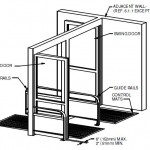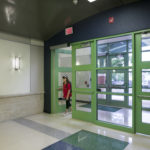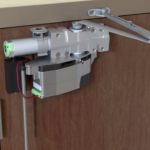 In yesterday’s post I shared some photos and videos of the entrance door of a hotel, where we had been having our BHMA meeting. As a group of us returned from dinner, we walked through the pair of doors, which opened automatically as we approached. As someone commented yesterday, the doors did not have automatic door signage, but in addition, it seemed that the doors were opening automatically when a sensor detected our presence.
In yesterday’s post I shared some photos and videos of the entrance door of a hotel, where we had been having our BHMA meeting. As a group of us returned from dinner, we walked through the pair of doors, which opened automatically as we approached. As someone commented yesterday, the doors did not have automatic door signage, but in addition, it seemed that the doors were opening automatically when a sensor detected our presence.
The reason this is important is because doors with low energy automatic operators must be actuated by a knowing act in compliance with BHMA A156.19 – the standard that addresses power assist and low energy power operated doors. If a door with a low energy operator is actuated by a sensor instead of a knowing act, the door must comply with a different standard – BHMA A156.10. This standard addresses power operated pedestrian doors, and would require the doors to be equipped with additional safety features – like safety sensors and guide rails.
After going back outside to look for a sensor and not finding one, I checked with Hayden at the desk. He showed us the wireless switch that the front desk agents use to open the door when they see guests approaching. So…is this considered a knowing act, even though the people using the door are not actuating the switch?
YES! The BHMA standard defines a knowing act this way: Any conscious action with the expected result of opening a door. This includes but is not limited to: wall or jamb-mounted contact or non-contact switches such as push plates; the action of manual opening (pushing or pulling) a door; and controlled access devices such as keypads, card readers, wireless transmitters and keyswitches.
So the wireless transmitter at the front desk IS considered a knowing act, and the low energy operators are not required to comply with BHMA A156.10 which would mandate guide rails, safety sensors, etc. As long as the doors comply with BHMA A156.19, they’re all set!
You need to login or register to bookmark/favorite this content.









BMHA doesn’t say WHO performs the “knowing act”
EXCELLENT Investigation!!! Thanks
And when the desk attendant isn’t watching you simply push the actuator to start the automatic door in motion?
Are we sure someone didn’t set this up on purpose to mess with the BHMA people?
LOL – That’s always a possibility! 🙂
– Lori
So a person in a submarine 2,000 miles away could theoretically push a button to open a door and it would still be compliant?
Also required in A156.19: When a knowing act switch is used to initiate the operation of the door operator, the doors shall be provided with signs on each side of the door – where the switch is located – with the message “ACTIVATE SWITCH TO OPERATE”
If the switch is located at the front desk, should the door to the front desk have the signage?
Why would signage be needed telling the person to activate switch to operate when the person approaching the door is not the one activating it?
I really appreciate all your help over the years, but I don’t agree with this interpretation. Feel free to tell me I’m wrong 🙂
Well…it’s not really an interpretation because A156.19 considers transmitters a knowing act, which is what was being used. I do agree that the signage saying to activate the switch is a little weird in this (unusual) case, so maybe A156.19 should be updated to reflect this application.
– Lori
I realize my submarine analogy was ridiculous, but just making the point that it seems wrong to me that the knowing act can be actuated by someone not near the door. I can’t argue that it does not specify who must commit the knowing act. I believe the signage description implies that the knowing act be committed by someone at the door or using the door, and that is the intent of the standard. Of course if it is not written that way, intent can’t be proven.
Digging deeper, the switch location is described in A156.19: When a knowing act switch is used: it shall be installed in a location within view of the door; have an installation height of a minimum 34″ and a maximum 48″ or as specified by local codes; shall remain accessible from the swing side when the door is opened; and shall not be located in a position where the used would be in the path of the swinging door. If located 7 feet or more from the center of the door, there shall be an additional time delay of 2 seconds for each additional foot.
If the switch is behind the front desk it may be out of view; Being hand held, it obviously could be located above or below ADA height; If the desk is 37 feet away, the door will need to stay open for an additional 60 seconds. They probably wouldn’t want this if they are worried about a tailgater coming in a minute later.
Rather than update the signage language, I’d like to see them clarify the intent that the knowing act be committed by persons using the door. Thank you Lori, for all your experience with this!
I am happy the article was here to reference; I had one of those “I think I am right moments,” and I have said it for years.
The two things you don’t quote unless you are positive are Scripture and Code.
I have discovered a third, but that is for another post.
THANK YOU
B
I can’t wait to hear what the third is! 🙂
– Lori